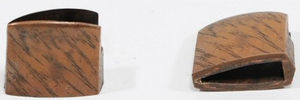Create Your First Project
Start adding your projects to your portfolio. Click on "Manage Projects" to get started
Japanese Wakizashi. Hizen Masahiro. Edo Period Kanei Era 1624
Hizen Masahiro Wakizashi - NBTHK Tokubetsu Hozon Paper
Signed: Hizen No Kuni Saga Ju Masahiro (Shodai- 1St Generation)
** CLICK IMAGES TO SEE LARGER **
(Shin To : Edo Period -寛永 Kanei Era 1624 AD )
NBTHK TOKUBETSU HOZON CERTIFICATE # 1006959
A sword designated as Extraordinarily Worthy of Conservation by the Society for the Preservation of the Japan Art Sword.
For a sword to receive TOKUBETSU HOZON, the sword would have had to clear the seven HOZON criteria to such a fantastic degree to realize such importance.
When swords achieve such standing, their value increases substantially.
In the "Kaihō-kenshaku": Hizen Masahiro blades are ranked as Wazamono. "Sharp Swords"
Fujishiro Ranking : Jyo Saku (Superior made)
*** It is worth noting that many sword experts consider his works to be Jyo Jyo Saku (Superior – Superior made). Some of his swords having achieved the highest ranking possible for swords: “NBTHK Juyo Token.”
Blade is polished
Nagasa (Length): 46.5 cm
Sori (Curvature) : 1.2 cm
Mekugi: 1
Width at hamachi: 2.7 cm
Width at kissaki: 2.0 cm
Saki Kasane: 4.5 cm
Jigane: Itame
Hamon: Gunome. Masahiro's brilliant Hamon reminds one of cumulonimbus clouds in summer. Many sword collectors love his Hamon that is rich in originality.
Koshirae:
Tsuba #1: Maru gata Iron .
Signed Choshu Hagi Ju Kawaji Saku. Edo Period
Tsuba #2: Wakizashi currently dressed with Hira Kaku gata Iron tsuba. Edo Period.
Tea ceremony umbrella, chrysanthemum flowers on leafy vine shakudo inlay .
To purchase this superb tsuba an additional $900.
Fuchi & Kashira matching legend:
Fuchi – Oni (little devil) tied to post.
Signed: Masanaga Saku. Edo Period
Kashira- Shoki the Demon Queller who catches Oni (little devils).
Kogatana: Ashinaga & Tenaga in high relief, gold highlights. Edo Period
Ashinaga (足長), has extremely long legs, Tenaga (手長), has extremely long arms.
Menuki: Shakudo - Black - Dragon. Edo Period
Saya:. Dark Brown Ishime ji. Edo Period
Shirasaya:
This blade was produced in Hizen province, by Shodai (1st Generation) Masahiro, @ 1624 AD. (average working date).
Under the Fujiwaru ranking system he is rated "upper class" (Jyo – Saku).
On the Cutting Test rankings, his blades are rated as Wazamono. (Sharp Swords)
The first-generation Masahiro (Shodai) was born in Saga city of Hizen Province in the 12th year of Keicho (1607), a son of Yoshibonu who was a- son-in-law of 1st gen Tadayoshi. Hashimoto Sadenjiro, initial smith name Masanaga.
His father was Yoshinobu who was married to the daughter of the first generation Hizen Tadayoshi.
This would make Masahiro the grandson of the founder of the Hizen Tadayoshi lineage.
Masahiro’s father, Yoshinobu, died young at the age of 29 so he was only able to teach Masahiro for a short period.
Luckily for him, Masahiro was also under the tutelage of his grandfather, Shodai Tadayoshi.
Masahiro did not continue his craft in the mainline Hizen school.
He was, however, favored by his grandfather, Shodai Tadayoshi, and also the Nabeshima Daimyo of Hizen.
A contemporary of Hizen Tadahiro, and one of the finest swordsmiths of the Tadayoshi school, both he and Tadahiro were sword makers to the famous "Nabeshima Daimyo Family"
Thus, when he founded his own sideline Hizen lineage under his name, Masahiro, it carried more than the usual amount of importance and influence.
In the ninth year of Genna (A.D.1623) when he was 19 years old, he made a sword and demonstrated his prominent skill in front of the feudal lord Nabeshima Katsushige of Hizen-han and granted a smith name "Masahiro" In the 11th month, the 2nd year of Kanei (1625). In 1625 he officially received the name, Masahiro and a rice stipend of 20 koku of rice allowing him and his new school to flourish.
In 1628, the Nabeshima Daimyo gave him the title of “Kawachi Daijô”. He did not start using this title until after 1641 for unknown reasons.
Masahiro's rather short, but prolific career ended when he passed away on February 5, the 5th year of Kanbun (1665 AD). at the age of 59.
Masahiro's works were highly valued during his lifetime, as well as now by collectors, seldom seen, and quite scarce. Some of his blades have received the highest ranking possible for a sword “NBTHK Juyo Token.”
This superb sword was first registered. Showa 28th year - 1953.
An indication that is was in the possession of the former owners for generations, passed down as a family heirloom.
A$10.800
Legend on the Fuchi & Kashira:
Shoki, also known as Zhong Kui in China, is a figure known as the "Demon Queller," who is revered for protecting people from evil spirits and diseases.
His legend originates from China, where he was a scholar who, after failing an imperial examination, tragically took his own life. Moved by his talent and dedication, the emperor honoured him with a state burial and posthumously awarded him a title.
In gratitude, Shoki's spirit vowed to protect the emperor and his empire from demons, which led to his adoption and adaptation in Japan as a powerful guardian figure
Legend on the Kozuka:
Ashinaga (足長), has extremely long legs, while the other,Tenaga (手長) has extremely long arms.
They are are a pair of yōkai, supernatural creatures of Japanese folklore first described in the Japanese Encyclopedia Wakan Sansai Zue in 1712 .
They are said to be found in Kyūshū.
They subsist by fishing, with the long-legged Ashinaga carrying Tenaga, who scoops fish from the water with his long arms.

































